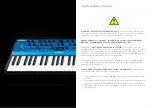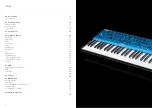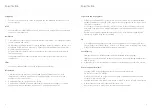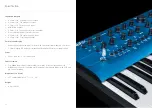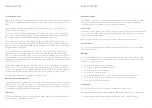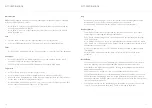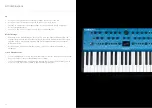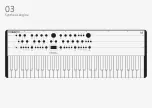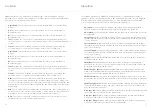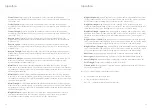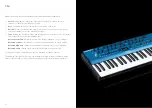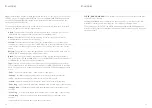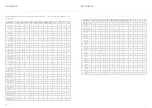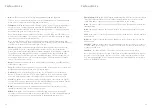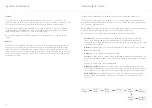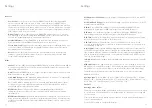
26
27
Oscillators
COBALT8X features two independent oscillator groups, each containing 34 different
algorithms. There is a Mix control between the oscillator groups and an extended Oscillator
Drift control for creating huge super-sounds.
•
Algorithm1:
This encoder allows you to select which algorithm to use for Oscillator
Group 1.
•
A1:
This encoder allows you to control the Param A for the selected algorithm on
Oscillator Group 1.
•
B1:
This encoder allows you to control the Param B for the selected algorithm on
Oscillator Group 1.
•
Tune1:
Holding the ‘Shift’ button (or when latched in shift mode) and turning this
encoder allows us to control the coarse tuning of Wave1 (Tune) at desirable int/- 2
octaves.
•
Fine1:
Holding the ‘Shift’ button (or when latched in shift mode) and turning this
encoder allows us to control the fine tuning of Wave1 (Fine) +/- 100 cents.
•
Algorithm2:
This encoder allows you to select which algorithm to use for Oscillator
Group 2.
•
A2:
This encoder allows you to control the Param A for the selected algorithm on
Oscillator Group 2.
•
B2:
This encoder allows you to control the Param B for the selected algorithm on
Oscillator Group 2.
•
Tune2:
Holding the ‘Shift’ button (or when latched in shift mode) and turning this
encoder allows us to control the coarse tuning of Wave2 (Tune) at desirable int/- 2
octaves.
•
Fine2:
Holding the ‘Shift’ button (or when latched in shift mode) and turning this
encoder allows us to control the fine tuning of Wave 2 (Fine) +/- 100 cents.
•
Glide:
Holding the ‘Shift’ button (or when latched in shift mode) and turning this
encoder controls the speed with which the oscillators change their pitch, ‘sliding’ from
one note to the next one pressed. Positive values control the amount of Auto Glide and
negative values control the amount of Legato Glide and will only glide if another note is
already held.
•
Mix:
This encoder allows you to balance the volume between each oscillator group. All
the way to the left you will hear only Algorithm 1, All the way to the right you will hear
Algorithm 2. In the centre you will hear a balanced blend of both waves.
•
Drift:
This encoder controls the oscillator drift amount. This is the amount of slop or
random detuning of each oscillators phase and tune.
Algorithms
The available algorithms on COBALT8X include a variety of complex analogue synthesis
techniques, built in cross-modulation (SYNC, RM, and many more), PWM, smooth Morphing
between VA waves, bit crushing and filtered noise. Each algorithm has carefully curated
controls that make complex synthesis simple with just two parameters.
•
VA Sweep:
Sweep through sine, triangle, saw, square, pulse (with pulse width) (A),
ability to detune the oscillators (or snap to musical intervals) using spread (B)
•
VA Crushed:
Sweep through sine, triangle and saw shapes (A) with real-time control over
bit crushing (B)
•
Spread Saw:
Spread mode with increased oscillator count, ability to blend between the
fundamental and detuned oscillators (A) and more comprehensive spread (B) options (e.g
oct up + detuned)
•
Spread Square:
Spread mode with increased oscillator count, ability to blend between
the fundamental and detuned oscillators (A) and more comprehensive spread (B) options
(e.g oct up + detuned)
•
Spread Triangle:
Spread mode with increased oscillator count, ability to blend between
the fundamental and detuned oscillators (A) and more comprehensive spread (B)options
(e.g oct up + detuned)
•
PWM:
Classic Pulse Width Modulation with width control (A) and ability to detune the
oscillators using spread (B)
•
PWM Dual:
PWM mode where as the width control (A) changes, the pulse width
increases in the first cycle of the wave and decreases in the second cycle. Oscillators can
be detuned using the spread (B) control
•
PWM Triangle / Square:
Alternating triangle and square waves with control over the
width of the triangle portion (A) and an asymmetry control (B) that allows every second
cycle to have a different triangle width (inverse) to the first
•
PWM Saw Eraser:
Wave with both a saw and PWM portion, with control over the ratio
between the two portions (A) and the width of the PWM portion (B) relative to parameter
A
•
PWM Triangle Pinch:
Triangle wave with pulse width modulation (A) and an asymmetry
control (B) which allows every second cycle of the wave to have a different width to the
first (can be wider or narrower)
•
Hard Sync Saw:
Classic hard sync with un-quantised ratio (A) that can be blended with a
sub oscillator (B) one octave below the fundamental
•
Hard Sync Square:
Classic hard sync with un-quantised ratio (A) that can be blended
with a sub oscillator (B) one octave below the fundamental
•
Hard Sync Triangle:
Classic hard sync with un-quantised ratio (A) that can be blended
with a sub oscillator (B) one octave below the fundamental
Summary of Contents for COBALT8X
Page 13: ...24 25 03 Synthesis engine...


